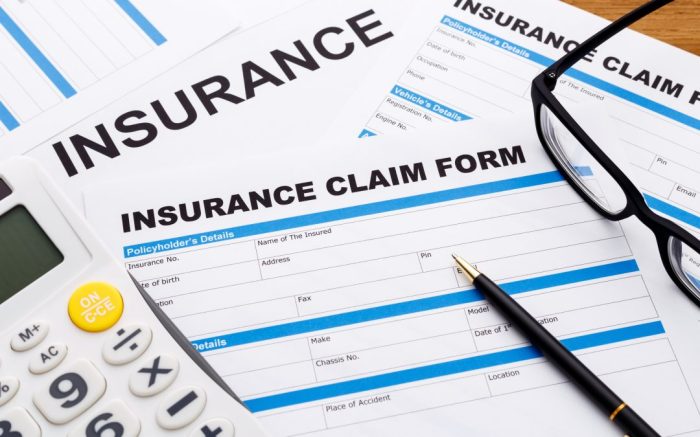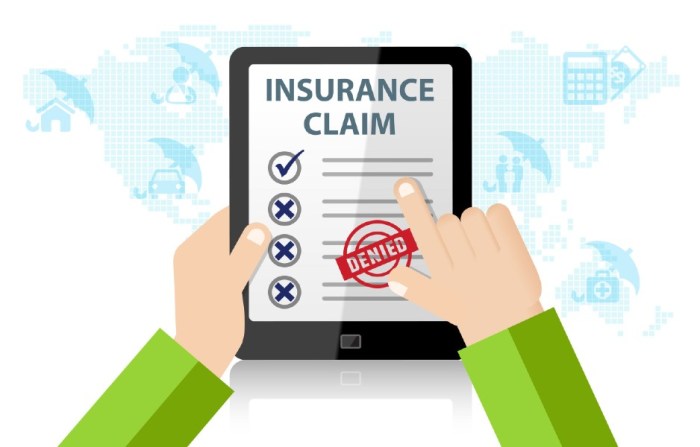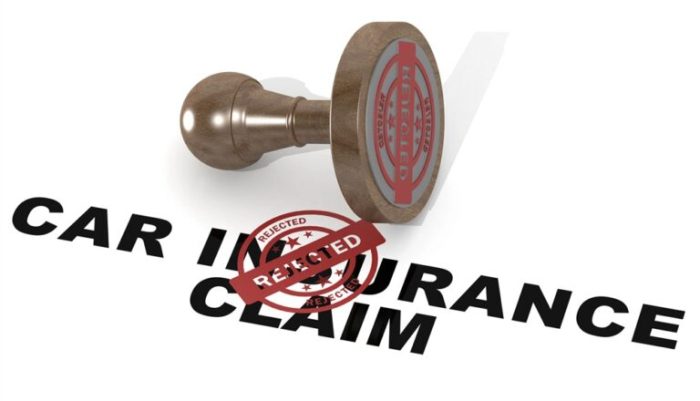What to do if car insurance company denies your claim? That sinking feeling when your insurer rejects your claim is, frankly, the worst. Suddenly, you’re facing unexpected repair bills and a bureaucratic maze. But don’t panic! This guide breaks down the process step-by-step, from understanding your policy to exploring your legal options. We’ll equip you with the knowledge and strategies to fight back and potentially recover what’s rightfully yours.
We’ll cover everything from meticulously reviewing your denial letter and gathering irrefutable evidence to crafting effective communication with your insurance company and navigating the sometimes-tricky waters of mediation or arbitration. Think of this as your ultimate survival guide for navigating the insurance claim denial wilderness. Let’s get started.
Reviewing the Denial Letter
So, your car insurance claim got denied. Ouch. Before you throw your hands up in the air, take a deep breath and carefully review the denial letter. It’s your roadmap to understanding why your claim was rejected and what you can do next. This isn’t just a piece of paper; it’s a crucial document containing the reasons behind the insurance company’s decision. Understanding it is the first step towards potentially reversing the decision.
Understanding the specific reasons for denial is key to your next steps. The letter might seem like legal jargon, but breaking it down will make it more manageable. The insurance company is obligated to provide a clear explanation, so don’t be intimidated.
Sample Denial Letter and Key Information
Let’s imagine a sample denial letter. It might start with a formal salutation, followed by a reference number for your claim (e.g., Claim #1234567). Then, the core of the letter would state the denial. For example: “This letter confirms that your claim for collision damage to your vehicle on October 26, 2024, has been denied due to a breach of your policy contract.” Following this would be the specific reasons for the denial. This could include things like: “Your policy excludes damage caused by driving under the influence of alcohol,” or “Your failure to report the accident within the 24-hour reporting period as stipulated in your policy violates the terms and conditions.” Finally, the letter will usually include contact information for appealing the decision and information about your rights.
Key information to look for includes the claim number, the date of the incident, the specific reason(s) for denial, the policy provisions violated (if any), the contact information for appeals, and the deadline for appealing the decision. Missing any of this information can hinder your ability to effectively respond.
Organizing Information from the Denial Letter
Once you’ve carefully read the denial letter, organize the information. A simple table can be helpful. For example:
| Item | Information |
|---|---|
| Claim Number | 1234567 |
| Date of Incident | October 26, 2024 |
| Reason for Denial | Driving under the influence of alcohol (policy exclusion) |
| Policy Violation | Policy section 4.2 – prohibited substances |
| Appeal Deadline | November 26, 2024 |
| Contact Information | [Phone number and email address] |
This structured approach makes it easy to identify the core issues and prepare a strong response or appeal. Remember, this is a crucial step in potentially getting your claim approved. Don’t skip it.
Gathering Evidence
So, your insurance company denied your claim. Don’t panic! Armed with the right evidence, you can significantly strengthen your case and potentially overturn their decision. This means meticulously gathering and organizing all relevant documentation to support your version of events. Think of it as building a compelling case file – the stronger your evidence, the better your chances.
This section details the crucial evidence you’ll need to collect and how to present it effectively. Remember, clarity and organization are key. A messy presentation can weaken even the strongest evidence.
Essential Documents Checklist
Compiling a comprehensive list of documents is the first step. This isn’t just about throwing everything together; it’s about strategically selecting documents that directly support your claim. Missing even one key piece of evidence could significantly hinder your efforts.
- Your insurance policy: This is your foundational document. It Artikels your coverage, terms, and conditions. Make sure you have a readily accessible copy.
- The accident report (police report, if applicable): An official police report lends significant weight to your claim, providing an unbiased account of the incident.
- Photos and videos of the damage: Visual evidence is invaluable. We’ll discuss this in more detail below.
- Medical records and bills: If injuries were involved, these documents are essential to substantiate your claim for medical expenses.
- Repair estimates: Obtain multiple estimates from reputable repair shops to demonstrate the extent of the damage and the associated costs.
- Witness statements: If anyone witnessed the accident or can corroborate your account, obtain written statements from them. Include their contact information.
- Communication with the insurance company: Keep copies of all correspondence, including emails, letters, and phone call notes. This demonstrates your attempts to resolve the issue amicably.
Organizing and Presenting Evidence
Once you’ve gathered your evidence, organizing it logically is crucial. A haphazard presentation can confuse the insurance adjuster and weaken your case. Consider using a system that allows for easy access and review.
A simple approach is to create a chronologically ordered binder or digital folder. Each section should contain related documents, clearly labeled and easily accessible. For instance, a section for “Police Report and Accident Details,” another for “Medical Records,” and so on. A concise summary sheet outlining the key points of your claim and how each piece of evidence supports it would be beneficial.
The Power of Photographic Evidence
Photos and videos are arguably the most compelling type of evidence. They provide irrefutable visual proof of the damage, the accident scene, and the extent of your injuries (if any). However, simply taking pictures isn’t enough. The quality and context of your photos are critical.
To maximize the impact of your photographic evidence:
- Take multiple photos from various angles: Capture the damage from different perspectives to provide a complete picture.
- Include reference points: Use a ruler or other object to show the scale of the damage. This helps to accurately assess the extent of the damage.
- Capture the surrounding environment: Include photos of the accident scene, showing road conditions, traffic signs, and any other relevant details. For example, if the accident happened on a poorly lit road, photos showing the poor lighting can support your claim.
- Document injuries: If injured, take photos of your injuries, including any bruising, cuts, or swelling. Time-stamped photos can be especially valuable.
- Maintain high resolution: Use a camera or smartphone with a high-resolution camera to ensure clear, detailed images.
Contacting the Insurance Company
Getting your car insurance claim denied can feel like a punch to the gut, but don’t throw in the towel just yet. Effective communication with your insurance company is crucial in getting your claim reconsidered. This involves both verbal and written communication, both equally important in navigating this process.
Remember, your goal is to be assertive, not aggressive. You’re not trying to start an argument; you’re trying to present your case clearly and concisely, using facts and evidence to support your claim. Keeping a calm and professional tone throughout your interactions will significantly increase your chances of a successful appeal.
So, your car insurance claim got rejected? Don’t freak out! First, review your policy thoroughly. Then, gather all supporting documentation and formally appeal the decision. If you’re in Norman, Oklahoma, and need a reliable insurer, consider checking out aaa insurance norman oklahoma for future coverage. After appealing, if the denial persists, consult with a legal professional to explore your options for further action.
Phone Call Script for Discussing Claim Denial
Before calling, gather your policy number, claim number, and any relevant documentation. Have your notes and evidence readily available. A concise and organized approach is key to a productive conversation. Here’s a sample script:
“Hello, my name is [Your Name], and my policy number is [Policy Number]. My claim number is [Claim Number]. I’m calling to discuss the denial of my claim, which I received on [Date]. I’ve reviewed the denial letter, and I believe there are some discrepancies. I’d like to discuss [Specific reason for discrepancy, e.g., the damage assessment, the witness statements]. I have documentation to support my claim, and I’m available to provide further information as needed.”
After stating your case, listen carefully to the representative’s response. Ask clarifying questions if needed, and remain polite and respectful throughout the conversation. Note down the representative’s name, the date and time of the call, and any agreements or promises made.
Formally Appealing a Claim Denial in Writing
A formal written appeal provides a documented record of your claim and strengthens your position. It allows you to systematically present your evidence and arguments in a clear and organized manner. Ensure your appeal includes all relevant information and follows your insurance company’s specific appeals process, which should be Artikeld in your policy or the denial letter.
Your written appeal should include:
- Your policy number and claim number.
- The date of the initial claim and the date of the denial letter.
- A clear and concise statement explaining why you disagree with the denial.
- Detailed evidence supporting your claim, such as photos, repair estimates, police reports, witness statements, etc. Clearly reference each piece of evidence and explain how it supports your case.
- A summary of your desired outcome (e.g., full or partial claim payment).
- Your contact information.
Send your appeal via certified mail with return receipt requested to ensure proof of delivery. Keep a copy of the appeal and all supporting documents for your records.
Examples of Professional and Assertive Communication Techniques
Maintaining a professional and assertive tone is essential when dealing with insurance companies. This means being firm in your stance while remaining respectful and avoiding accusatory language. Here are some examples:
- “I understand your position, however, I believe the assessment of the damage is inaccurate based on [evidence].”
- “I respectfully disagree with the conclusion in the denial letter. My supporting evidence clearly demonstrates [your point].”
- “I request a review of my claim based on the additional evidence I’ve provided. I’m confident a thorough review will lead to a different outcome.”
Avoid phrases like “You’re wrong” or “This is unacceptable.” Instead, focus on presenting facts and evidence objectively and calmly. Remember, a calm and professional approach is more likely to yield positive results.
Mediation and Arbitration

Source: get-meducated.com
So, your insurance company denied your claim, and you’ve exhausted all other avenues. Don’t despair! Mediation and arbitration offer alternative dispute resolution (ADR) methods that can help you get a fair settlement without the expense and stress of a full-blown lawsuit. These processes involve a neutral third party who helps both sides reach an agreement.
Mediation is a less formal process than arbitration, focusing on finding a mutually agreeable solution. It’s often a cost-effective first step before escalating to more binding procedures. The mediator facilitates communication, helps identify common ground, and proposes solutions, but ultimately, the decision rests with the parties involved. Think of the mediator as a skilled facilitator, guiding the conversation toward a compromise.
Mediation Process, What to do if car insurance company denies your claim
The mediation process typically begins with an initial meeting to establish ground rules and expectations. Then, each party presents their case to the mediator and the other party. The mediator will then work to help both sides understand each other’s perspectives and find areas of agreement. This often involves a series of back-and-forth discussions, facilitated by the mediator, with the goal of creating a mutually acceptable settlement. If a settlement is reached, it’s usually documented in a legally binding agreement.
Arbitration Process
If mediation fails to resolve the dispute, arbitration might be the next step. Unlike mediation, arbitration is more formal and binding. An arbitrator, a neutral third party with expertise in the relevant area (like insurance claims), will hear evidence and arguments from both sides and then render a decision. This decision is generally legally binding, meaning both parties must abide by the arbitrator’s ruling. The arbitration process typically involves submitting documents, presenting evidence, and potentially having a hearing similar to a court proceeding, albeit often less formal.
Mediator vs. Arbitrator
The key difference lies in the power they hold. A mediator acts as a facilitator, guiding the discussion and suggesting solutions but ultimately leaving the decision-making to the involved parties. An arbitrator, on the other hand, acts as a judge, hearing evidence and making a final, binding decision. Mediation prioritizes collaboration and compromise, while arbitration emphasizes a more formal, adjudicative process. Choosing between the two depends on the complexity of the claim, the willingness of both parties to compromise, and the desired level of formality. For example, a smaller claim might be suitable for mediation, while a complex claim involving significant financial implications might require arbitration for a more definitive outcome.
Legal Options: What To Do If Car Insurance Company Denies Your Claim
So, you’ve exhausted all other avenues, and your insurance company still refuses to pay your legitimate claim. The question now becomes: what are your legal options? Taking legal action against an insurance company is a significant step, but sometimes it’s the only way to secure the compensation you deserve. It’s crucial to understand the circumstances under which legal action is warranted and the process involved.
Filing a lawsuit against an insurance company is a complex process that requires careful consideration and often the assistance of legal counsel. It’s not a decision to be taken lightly, as it can be time-consuming and costly. However, in situations where the insurance company has acted in bad faith, clearly violated the terms of your policy, or demonstrably denied a valid claim, pursuing legal action may be your best recourse. Remember, proving bad faith often requires showing a pattern of unreasonable conduct or a deliberate attempt to avoid paying a legitimate claim.
Circumstances Warranting Legal Action
Legal action against an insurance company might be necessary when the insurer has demonstrably acted in bad faith, such as denying a claim without proper investigation or providing misleading information. Another scenario is when the denial is based on a misinterpretation or clear violation of the policy’s terms and conditions. For example, if your policy covers a specific type of damage, but the insurance company denies coverage based on a technicality not explicitly stated in the policy, legal action might be appropriate. Finally, if the insurance company fails to meet reasonable deadlines or engage in meaningful negotiations, this could also justify pursuing legal recourse. The threshold for proving bad faith varies by jurisdiction and specific case details, so consultation with a lawyer is crucial.
Filing a Lawsuit
The process of filing a lawsuit against an insurance company begins with consulting an attorney specializing in insurance claims disputes. They will review your case, assess its merits, and advise you on the best course of action. The attorney will then file a complaint with the appropriate court, outlining the facts of your case and the legal grounds for your claim. The insurance company will then file a response, and the process may involve discovery (exchanging information and evidence), depositions (sworn testimony), and potentially, pretrial motions. If the case cannot be settled out of court, it will proceed to trial. The specific procedures and timelines vary significantly depending on the jurisdiction and the complexity of the case.
Potential Legal Costs
Pursuing a claim in court can be expensive. Potential costs include attorney fees, which can be substantial depending on the complexity of the case and the attorney’s hourly rate or contingency fee agreement. Court filing fees are another expense, and there may be costs associated with expert witnesses, such as accident reconstruction specialists or medical professionals, if their testimony is necessary. Additional expenses could include costs for obtaining and presenting evidence, such as medical records or police reports. Depending on the outcome, you may also be responsible for the opposing party’s costs if you lose the case. It’s advisable to discuss all potential costs with your attorney upfront to understand the financial implications of pursuing legal action. Many lawyers work on a contingency fee basis, meaning they only get paid if you win your case, reducing the upfront financial burden. However, even with contingency fees, there will likely be other expenses. For example, a case involving significant damages might require thousands of dollars in expert witness fees even if the lawyer doesn’t charge an upfront retainer.
Preventing Future Denials
Navigating insurance claim denials is stressful, but proactive steps can significantly reduce your risk. By maintaining meticulous records and fostering clear communication with your insurer, you can build a strong foundation for smoother claims processing in the future. This proactive approach not only saves you time and frustration but also protects your financial well-being.
A proactive approach to insurance management is your best defense against future claim denials. This involves more than just paying your premiums; it requires actively managing your policy and documentation to ensure you’re adequately covered and prepared for any unforeseen circumstances.
Proactive Steps to Minimize Claim Denial Risk
Taking preventative measures is key to avoiding the headache of a denied claim. These actions demonstrate your commitment to responsible insurance practices and can strengthen your position should a claim ever become necessary.
- Regular Policy Review: Annually review your policy to ensure coverage aligns with your current needs and assets. Consider changes in your life, such as a new car, home improvements, or increased valuable possessions.
- Accurate Information: Always provide complete and accurate information when applying for insurance or updating your policy. Inaccuracies can lead to coverage gaps or denials.
- Proper Documentation: Maintain thorough records of all vehicle maintenance, home repairs, and valuable possessions. This documentation can be crucial in supporting your claim.
- Understand Your Policy: Familiarize yourself with your policy’s terms, conditions, exclusions, and deductibles. Understanding your coverage limits prevents misunderstandings and potential disputes.
- Prompt Reporting: Report incidents promptly to your insurance company. Delayed reporting can negatively impact your claim.
Maintaining Thorough and Accurate Insurance Records
Maintaining organized and comprehensive insurance records is crucial for a smooth claims process. This detailed record-keeping minimizes the risk of disputes and facilitates a quicker resolution should you need to file a claim.
- Centralized System: Use a dedicated file (physical or digital) to store all insurance-related documents. This includes policy documents, claim forms, correspondence, receipts, and repair invoices.
- Regular Backups: If using a digital system, regularly back up your files to prevent data loss. Consider cloud storage or external hard drives.
- Detailed Documentation: Keep detailed records of all relevant information, including dates, times, locations, and witness details. For car accidents, gather police reports and witness statements.
- Photographic Evidence: Take photos and videos of damaged property, vehicles, or injury sites. These visual aids can significantly support your claim.
Clear and Comprehensive Communication with Your Insurance Company
Effective communication is vital throughout the insurance process. Clear and concise communication minimizes misunderstandings and facilitates a more efficient claims resolution.
- Detailed Claim Reports: When filing a claim, provide a detailed account of the incident, including all relevant information. Avoid ambiguity or generalizations.
- Prompt Responses: Respond promptly to all communication from your insurance company. Delayed responses can hinder the claims process.
- Maintain Professionalism: Maintain a professional and respectful tone in all communications. Avoid emotional outbursts or aggressive language.
- Follow Up: If you haven’t received a response within a reasonable timeframe, follow up with your insurer to check on the status of your claim.
- Keep Records of Communication: Maintain records of all communication, including emails, letters, and phone calls. This documentation is valuable if disputes arise.
Illustrative Examples (Table)

Source: eclaimstatus.com
Understanding how insurance claim denials play out in real-world scenarios can be incredibly helpful. Seeing concrete examples clarifies the process and highlights the importance of strong evidence. The following table illustrates different situations, the reasons for denial, the necessary evidence, and the potential outcomes.
Remember, the outcome of a denied claim can vary based on several factors, including the specifics of your policy, the strength of your evidence, and the insurance company’s internal procedures. Always consult with legal counsel if you feel your claim was unjustly denied.
Scenario Examples and Outcomes
| Scenario | Reason for Denial | Evidence Needed | Outcome |
|---|---|---|---|
| Car damaged in a parking lot with no witnesses. | Lack of evidence of how the damage occurred; suspicion of pre-existing damage. | Photos of the damage, police report (if filed), repair estimates, testimony from any potential witnesses (even if indirect, such as security camera footage), and documentation showing the car was undamaged prior to the incident (e.g., recent car inspection report). | Claim likely denied initially; appealing with strong evidence (like security footage) might lead to partial or full coverage. Without strong evidence, the claim is unlikely to be successful. |
| Accident involving an uninsured driver; driver fled the scene. | Lack of information on the at-fault driver. | Police report detailing the accident and the absence of the other driver, photos of the damage, witness statements, medical records documenting injuries, and any evidence gathered at the scene. | Depending on your policy’s uninsured/hit-and-run coverage, the claim might be successful. A strong police report and supporting evidence are crucial. If the policy doesn’t cover uninsured drivers, the claim will be denied. |
| Damage caused by a natural disaster (e.g., hail storm) exceeding policy limits. | Damage exceeding policy coverage limits. | Photos and video documentation of the damage to your vehicle, a detailed appraisal of the repair costs, and a copy of your insurance policy clearly outlining coverage limits. | Claim will likely be partially covered up to the policy limit. Any damages exceeding the policy limits will not be covered. |
Closure

Source: petrarcalaw.com
Getting your car insurance claim approved isn’t always a smooth ride. But armed with the right knowledge and a proactive approach, you can significantly increase your chances of a successful outcome. Remember, understanding your policy, gathering strong evidence, and communicating assertively are key. Don’t hesitate to seek legal counsel if needed—it might be the best investment you make. Stay informed, stay persistent, and remember, you have rights.



